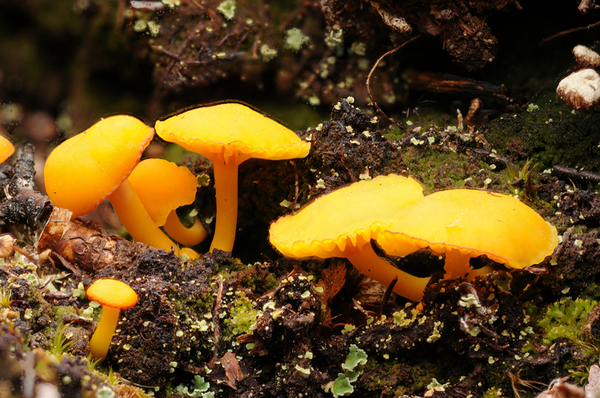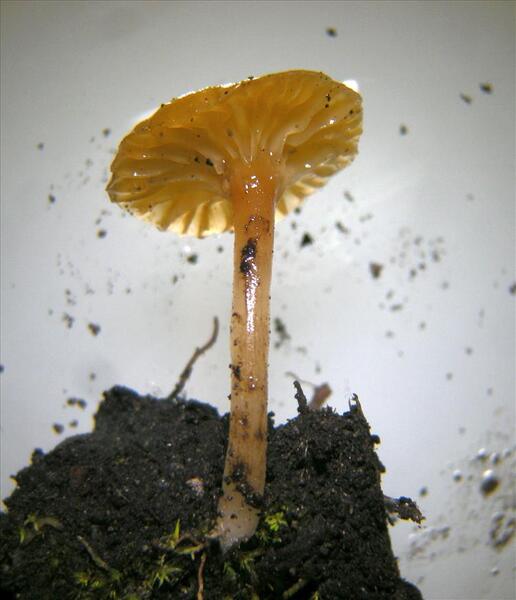Lichenomphalia alpina (Britzelm.) Redhead, Lutzoni, Moncalvo & Vilgalys
Mycotaxon, 83: 36, 2002. Basionym: Agaricus alpinus Britzelm. - Ber. naturhist. Ver. Augsburg 30: 13, 1890.
Synonyms: Botrydina luteovitellina (Pilát & Nannf.) Redhead & Kuyper; Botrydina vulgaris Bréb. p.p.; Cantharellus dovrefjeldiensis Henn. & Kirschst.; Gerronema alpinum (Britzelm.) Bresinsky & Stangl; Gerronema luteovitellinum (Pilát & Nannf.) Singer; Omphalia alpina (Britzelm.) Sacc.; Omphalia flava (Cooke) F.H. Møller; Omphalia luteovitellina Pilát & Nannf.; Omphalia umbellifera var. citrina (Quél.) Sacc.; Omphalina alpina (Britzelm.) Bresinsky & Stangl; Omphalina flava (Cooke) M. Lange; Omphalina luteovitellina (Pilát & Nannf.) M. Lange
Distribution: N - TAA (Nascimbene & al. 2007, 2022).
Description: Thallus crustose, episubstratic, forming a soft, gelatinous (when wet), green to dark green film made of spherical granules consisting of clumps of algal cells incompletely surrounded by (2.5-)3-4(-6) µm thick, appressed pseudoparenchymatous hyphae with 1-1.5 µm thick walls. Clamp connections absent in all hyphae. Basidiocarps not lichenized, with a 0.5-1.5 cm wide, bright yellow to orange-yellow, omphaloid, marginally striate cap, concolorous or slightly paler, decurrent, veined and sometimes forked lamellae, and a 1-1.5 cm high, 1.5-2.5 mm thick stipe which is more or less concolorous with cap, and pubescent throughout. Pileipellis with an encrusting, never zebroid pigment. Basidia clavate, mostly with 4 sterigmata (rarely with 1 or 2 sterigmata), 27-45 x 5-8 µm. Basidiospores 1-celled, hyaline, ellipsoid, 6.5-9(-9.5) x 3.5-4.5(-5) µm, thin-walled. Photobiont chlorococcoid (Coccomyxa). Spot tests: all negative. Chemistry: thallus without lichen substances.Note: a basidiolichen of acid organic soil, most common around treeline; perhaps more widespread in the Alps but overlooked by lichenologists.
Growth form: Crustose
Substrata: lignum, soil, terricolous mosses, and plant debris
Photobiont: green algae other than Trentepohlia
Reproductive strategy: mainly sexual
Commonnes-rarity: (info)
Alpine belt: extremely rare
Subalpine belt: very rare
Oromediterranean belt: absent
Montane belt: absent
Submediterranean belt: absent
Padanian area: absent
Humid submediterranean belt: absent
Humid mediterranean belt: absent
Dry mediterranean belt: absent

Predictive model
Growth form: Crustose
Substrata: lignum, soil, terricolous mosses, and plant debris
Photobiont: green algae other than Trentepohlia
Reproductive strategy: mainly sexual
Commonnes-rarity: (info)
Alpine belt: extremely rare
Subalpine belt: very rare
Oromediterranean belt: absent
Montane belt: absent
Submediterranean belt: absent
Padanian area: absent
Humid submediterranean belt: absent
Humid mediterranean belt: absent
Dry mediterranean belt: absent

Predictive model
 INDEX FUNGORUM
INDEX FUNGORUM
 GBIF
GBIF
 DOLICHENS
DOLICHENS



